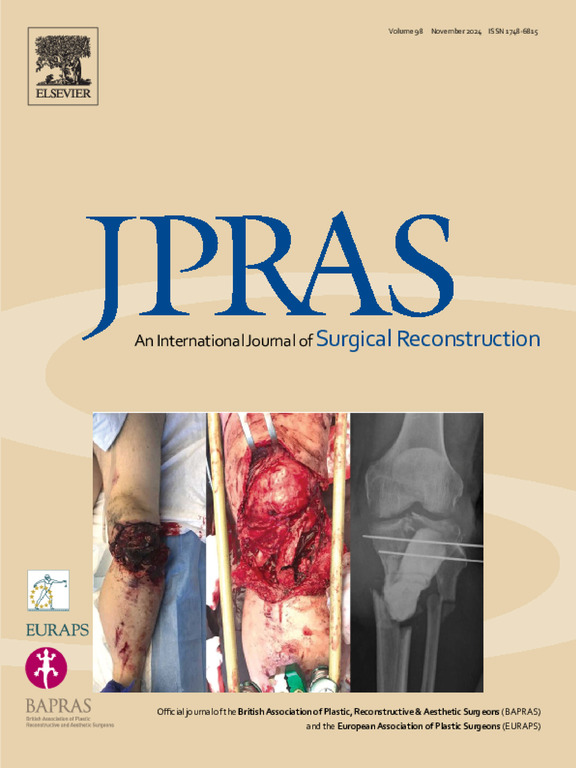Erosive Pustular Dermatosis: An important differential diagnosis for the non-healing burn wound
IF 2
3区 医学
Q2 SURGERY
Journal of Plastic Reconstructive and Aesthetic Surgery
Pub Date : 2025-03-05
DOI:10.1016/j.bjps.2025.03.008
引用次数: 0
Abstract
Introduction
Erosive Pustular Dermatosis (EPD) presents a diagnostic challenge due to its non-specific biopsy findings and clinical features which overlap with other dermatological conditions but should be suspected in non-healing burns wounds. We present our experience with the condition and an investigation and treatment algorithm.
Methods
Three cases of EPD complicating burn wound healing are presented; two males and one female, aged 32, 40 and 56 respectively, with an average total body surface area of 33% (range 24–46%).
Results
The average time post-burn before EPD was suspected was 18.9 months (range 3.6–34.2 months). All three patients began treatment with potent topical steroids, following dermatological advice. Their wounds fully healed within an average of 32 days (range 27–37 days) and they remain healed after a weaning protocol.
Conclusion
We propose a diagnostic and therapeutic algorithm for the investigation and management of suspected EPD in the non-healing burn wound to promote early detection and treatment, thus reducing the ongoing burden of injury for burn survivors. Moving forward, it is essential for burn care providers to be aware of and maintain a high index of suspicion for EPD in patients with non-healing burn wounds, especially those resistant to conventional treatments.
导言腐蚀性脓疱性皮肤病(EPD)由于其非特异性活组织检查结果和临床特征与其他皮肤病重叠,给诊断带来了挑战,但在烧伤伤口不愈合的情况下,应予以怀疑。本报告介绍了我们的经验以及调查和治疗算法。结果烧伤后平均 18.9 个月(3.6-34.2 个月)才开始怀疑 EPD。所有三名患者都根据皮肤科医生的建议开始接受强效局部类固醇治疗。他们的伤口平均在 32 天(27-37 天不等)内完全愈合,并在断奶方案后保持愈合。结论我们提出了一种诊断和治疗算法,用于调查和处理烧伤未愈合伤口中的疑似 EPD,以促进早期发现和治疗,从而减轻烧伤幸存者的持续伤害负担。展望未来,烧伤护理人员必须意识到并保持对烧伤创面不愈合患者 EPD 的高度怀疑,尤其是那些对常规治疗耐药的患者。
本文章由计算机程序翻译,如有差异,请以英文原文为准。
求助全文
约1分钟内获得全文
求助全文
来源期刊
CiteScore
3.10
自引率
11.10%
发文量
578
审稿时长
3.5 months
期刊介绍:
JPRAS An International Journal of Surgical Reconstruction is one of the world''s leading international journals, covering all the reconstructive and aesthetic aspects of plastic surgery.
The journal presents the latest surgical procedures with audit and outcome studies of new and established techniques in plastic surgery including: cleft lip and palate and other heads and neck surgery, hand surgery, lower limb trauma, burns, skin cancer, breast surgery and aesthetic surgery.

 求助内容:
求助内容: 应助结果提醒方式:
应助结果提醒方式:


